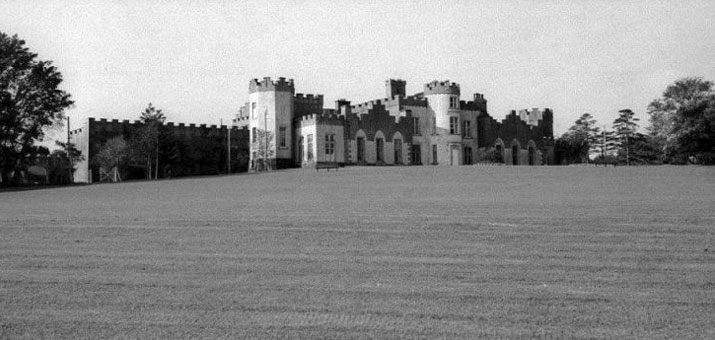The earliest references to cricket in the Fingal area are contained in the diaries of Mrs Taylor of Ardgillan when she mentions cricket in Hampton (Balbriggan) and in Rush in the 1820s. This is what was colloquially called "Big House" cricket where the gentry of an area played games against each other during the day and then had a tea-party and dance after the game. Hampton was again the venue when cricket was revived in Balbriggan in 1844. "Several gentlemen amateurs of that manly sport have applied to Mr George A. Hamilton for the use of the old ground in his demesne", and on 15 July 1844, Balbriggan beat Rathmines by an innings and 38 runs.
 Ardgillan House
Ardgillan House
By the early 1860s, the focus had shifted from the Big Houses to the formation of cricket clubs although members of the gentry were centrally involved in these enterprises, and continued to provide the playing facilities, the equipment and the players. Malahide Cricket Club was founded in 1861 and Balbriggan Cricket Club was re-established on 12 May 1863. At the inaugural meeting, it was reported that "nearly the whole of the gentry of the neighbourhood and surrounding country have become members, and everything looks as if the Balbriggan Club, will ere long, become one of the best in Ireland."
Balbriggan played its first match on Saturday, 25 July 1863 on its "nicely situated ground." They batted first and placed what the newspaper account referred to as a "very respectable number of 75 to their account." After a game of two innings per side, the result was a win for Malahide, but this was deemed "highly creditable" for a young club to have played with "such success against such good players as the Malahide."
By 1866, Balbriggan CC was thriving, and this was recognised by John Lawrence's very influential Handbook of Cricket in Ireland. He published this handbook every year from 1865 to 1880, and his reports are an invaluable resource in a period when cricket was thriving in Ireland and it appeared that it would become the national summer sport. Lawrence did not hesitate to criticise if he considered that criticism was justified, and as such, he rendered an invaluable service to sports historians in providing commentary which was more objective than the deferential reports in the local and national newspapers. For the 1866 season, Lawrence reported that Balbriggan CC had 40 members who paid an annual subscription of 10s. He praised the club for "greatly" promoting cricket in the district by playing regular matches and for taking part "in a good deal of practice".
With everything going so well, it came as a surprise to read that the club folded in the 1867 season. No reason was given by HG Carey in his note to Lawrence, and Lawrence expressed his disappointment at this development:
It must be a source of regret that a club so near the metropolis, possessing all the advantages of easy transit, to contend with first-class clubs, should be allowed to pass away. Possibly, our esteemed correspondent could, if he took this matter in hand, resuscitate this club, and once more give our noble game a habitation in his neighbourhood".
By the mid-1870s, it was recognised by the mainstream Nationalist paper, the Freeman's Journal that cricket which had been considered was now recognised as "being good" for members of the general populace. In the words of a contributor to the Freeman's Journal 1875:
Country gentlemen should unite and form clubs in their county. These clubs should not be exclusively composed of gentlemen. The best men, whether gentlemen or otherwise should be found and got to play matches.
The leader writer of the Freeman's Journal weighed in with his comments regarding cricket on 26 April 1875:
It is only yesterday, comparatively speaking that the Ancient British recreation spread to Ireland, where it was at first rather unpopularised by the notion that it was altogether an aristocratic business and therefore a thing to merit the aversion of Demos. But people soon recognise what is good for themselves; speedily the healthful and enjoyable amusement began to supersede the rough and sometimes dangerous pastimes which had previously made the joy of popular leisure. At present, it is not exaggeration to say, cricket is known and played all over the island. We may take it for granted that the youth of the "next series" will establish it permanently. Freeman's Journal.
In the 1870s, there are very few reports of games, but in the ones, which are reported, the influence of the gentry continued to be very much in evidence. When Co. Meath played Malahide, the Hon. Mr Talbot "contributed 18 by steady play and held possession of his wicket to the last." The reply for Co. Meath was led by the Hon. Mr R. Plunket who scored 20, not out. The result of this game was Malahide 55, Co. Meath, 54. By the early 1880s, there was evidence of the democratisation of the sport in Fingal. There were names on the scorecards other than members of the gentry. Knockbrack CC was founded in 1880, and there were new teams in Skerries, Balbriggan, Garristown, The Naul and Balscadden.
